According to a World Health Organization (WHO) news release Friday, a major part of the largest emergency vaccination campaign against yellow fever ever attempted in Africa has been completed, with more than 7.7 million people vaccinated in record time in the city of Kinshasa, Democratic Republic of Congo (DRC). This has been accomplished through an extraordinary network of partnerships and collaborations.

In less than two weeks, the campaign successfully reached the targeted population of Kinshasa, most of them (7.3 million people) using an emergency vaccine – one fifth of the full dose of yellow fever vaccine. This dose sparing strategy was recommended by the WHO Strategic Advisory Group of Experts on Immunization (SAGE) as a short-term emergency measure to reach as many people as possible given limited supplies of the vaccine.
“WHO commends the Government of the DRC for this significant achievement to roll out such a complex campaign in such a short period of time,” said Dr Yokouide Allarangar, WHO Representative in the DRC.
Planning a mass vaccination campaign on this scale usually takes up to 6 months. This complex and ambitious emergency campaign was put in place in a matter of weeks to end transmission of yellow fever before the rainy season starts in September.
The dose sparing strategy required the purchase and shipment of 10 million specialized syringes as well as specific training of more than 40 000 vaccinators to use this new method.
The Ministry of Public Health, WHO and more than 50 global partners worked closely together through the complex planning and logistics needed to roll out the campaign in more than 8000 locations across the country – both in dense, urban areas and in hard-to-reach, remote border regions.
As of Thursday, there has been 2513 suspected cases from eight of 26 provinces in the DRC. 75 confirmed cases have been identified from 2164 suspected cases that have been laboratory tested, with 16 deaths (CFR: 21.33%).
Of the 75 confirmed cases, reported from seven provinces, 57 acquired infection in Angola, 13 are autochthonous , and five are cases of sylvatic transmission (not related to the outbreak).
For the second time this year, the Emergency Committee (EC) regarding yellow fever was convened by the Director-General under the International Health Regulations (2005) (IHR 2005) by teleconference on 31 August 2016 and for the second time it was the view of the Committee that the current status of the yellow fever outbreaks in Angola and the Democratic Republic of the Congo does not constitute a Public Health Emergency of International Concern (PHEIC). However, despite the considerable progress made, the Committee concluded that the outbreak remains a serious public health event.
Related:
- Bioterrorism expert responds to foiled Kenya anthrax attack
- Uganda’s progress toward river blindness elimination
- Anthrax attack foiled in Kenya


One thought on “Yellow fever: More than 7 million vaccinated in Kinshasa”